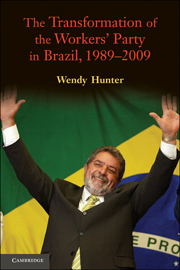Book contents
- Frontmatter
- Contents
- Tables, Charts, and Figure in Text
- Tables and Chart in the Appendix
- Acronyms
- Acknowledgments
- 1 Introduction: Understanding the Normalization of the Workers' Party
- 2 Strategic Change or Organizational Persistence? Evolution of the Workers' Party
- 3 Opposition Politics: The PT in the Chamber of Deputies
- 4 The PT in Municipal Government: The Pragmatic Face of the Party
- 5 Striving for the Presidency: From Opposition to Government
- 6 New Challenges and Opportunities: The PT in Government, 2003–2009
- 7 Analytical Implications and Comparative Perspectives
- Appendix
- References
- Interviews
- Index
6 - New Challenges and Opportunities: The PT in Government, 2003–2009
Published online by Cambridge University Press: 05 June 2012
- Frontmatter
- Contents
- Tables, Charts, and Figure in Text
- Tables and Chart in the Appendix
- Acronyms
- Acknowledgments
- 1 Introduction: Understanding the Normalization of the Workers' Party
- 2 Strategic Change or Organizational Persistence? Evolution of the Workers' Party
- 3 Opposition Politics: The PT in the Chamber of Deputies
- 4 The PT in Municipal Government: The Pragmatic Face of the Party
- 5 Striving for the Presidency: From Opposition to Government
- 6 New Challenges and Opportunities: The PT in Government, 2003–2009
- 7 Analytical Implications and Comparative Perspectives
- Appendix
- References
- Interviews
- Index
Summary
On January 1, 2003 Lula assumed office. Leftist circles in Brazil and abroad rejoiced over this long-awaited event. Nevertheless, remaining tensions – the radicalism of some PT factions on the one hand and Lula's efforts at moderation on the other – raised the question of which direction his government would take. Would the PT stand by its core programmatic ideals and historic principles or adapt to the constraints of the global economy and the institutionally derived incentives of Brazilian politics? Would it carry out the party's vision of redistributive state-led economic development, progressive social policy, and ethical government or would it conform in wholesale fashion to contemporary economic trends and the structure of Brazilian politics? With respect to these questions, many wondered whether Lula would be able to control the radicals inside the PT. Just as external economic and political constraints had eroded some of the PT's distinctiveness in the opposition, would the process of adaptation be furthered with the PT in government? How would the PT, as well as its relationship to Lula and his government, change as a result of government decisions? This chapter contends that the experience of government made it even more difficult to retain the norms, commitments, and policy orientations of the past and therefore contributed crucially to the PT's normalization.
- Type
- Chapter
- Information
- The Transformation of the Workers' Party in Brazil, 1989–2009 , pp. 146 - 176Publisher: Cambridge University PressPrint publication year: 2010

